Fairy Tales
Project 2000 -2003 | home  |
| |
PROJECT OBJECTIVES:
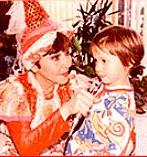 |
 uropean
fairy tale treasury - as a means of enhancing mutual understanding
and acceptance among young children of Europe. All activities
included, aim at developing comprehencive and creative abilities of
children /3 -7/, encouraging them to form and express opinions on ethic
notions. uropean
fairy tale treasury - as a means of enhancing mutual understanding
and acceptance among young children of Europe. All activities
included, aim at developing comprehencive and creative abilities of
children /3 -7/, encouraging them to form and express opinions on ethic
notions. |
|
|
 n
important part of the project is animating and giving extra informative
value to the programme material with the help of fairytales specially
chosen for each subject and
lesson. n
important part of the project is animating and giving extra informative
value to the programme material with the help of fairytales specially
chosen for each subject and
lesson.
|
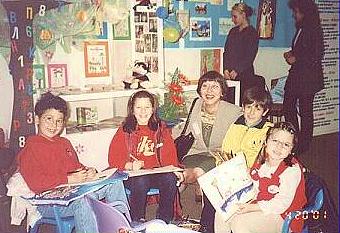 |
|
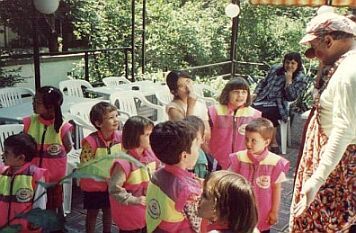 |
 etting pre-school children acquainted
to European fairytale heritage, and alongside with elements of Europeam
culture, history, social structure, geography, natural phenomenae and
architecture monuments. etting pre-school children acquainted
to European fairytale heritage, and alongside with elements of Europeam
culture, history, social structure, geography, natural phenomenae and
architecture monuments. |
|
 mprovement
and refinement of language skills, enriching vocabulary, development of
memory and imagination through reproducing, acting and inventing
tales. mprovement
and refinement of language skills, enriching vocabulary, development of
memory and imagination through reproducing, acting and inventing
tales. |
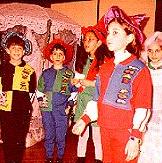
|
|
 |
 chieving greater comprehension
and higher memorization in language and other
lessons. chieving greater comprehension
and higher memorization in language and other
lessons.
Discovering and developing children’s
talents.
|
|
 ims regarding
children: ims regarding
children:
Emotional aspect: Enrichment of sensibility. Attaining
control over emotional impulsiveness.
Intelectual aspect: Developing
the ability for reasoning over the intentions, motives and after effects
of human behaviour. Comprehencion of etic and moral categories /good-bad,
truth-lie, generocity, bravery, etc./ |
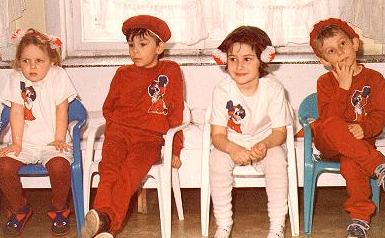
Understanding and accepting of common humanitarian
values.

|
|
|
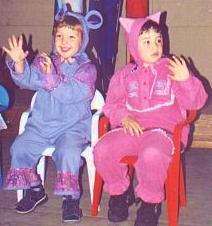
|
Activity
aspect: Development of movement abilities and hand skills.
|
Socialization : Adaptation and integration in
group, collective work and games. |
|
|
 ims
regarding teachers: ims
regarding teachers:
To motivate them in animating their mainstream lesson work :
Research, sellection, organization of material needed for work on the
project:
/ Fairytales, myths and legends, pictures, illustrations,
other books and atlasses./
1. Collecting, sistematizing, and processing
fairytales, myths and legends, interesting facts, geografic amd historical
data about different European countries and people, into a suitable for
the age of children
form.
2. Classification and
scheduling the collected material in regard to time, themes and lesson
units.
3. Working out special lesson units implicating the
cognitive elements into the plots of favourite
fairytales.
4. Preparing for and carying out purposeful
talks with children on moral and ethic themes prompted by the events and
characters of fairytales.
5. Preparation and organization of mobile and
cognitive games, tests and logic quizes based on fairytale episodes and
characters. |

|
|
|
 IMPACT
OF THE PROJECT ON THE PUPILS IMPACT
OF THE PROJECT ON THE PUPILS
The children involved took great interest
in all events and activities connected to the project.
|
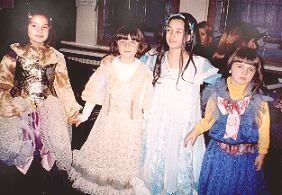
|
|
|
 heir
involvement had substantial and noticeable results in: heir
involvement had substantial and noticeable results in:
- Establishing a ffriendly and tlollerant atnospjere
in the working groups.
- Open and good-natured communications of the
children among themselves, and between children, teachers and other adults
they met with during the project work.
- Increased interest to the
learning process as a whole, a better comprehension, memorization and
reproducing in all programme subjects.
- Improved level of
language culture and behavior.
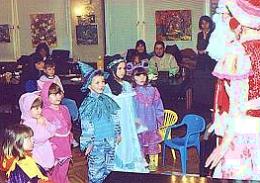
|
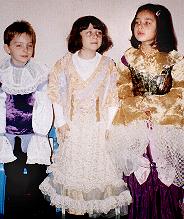
- Vivid
display of fantasy, artistizm, quick-wittedness, dexterity and handy
skills.
- Improved abilities for logical and analitical thinking,
generalization and drawing conclusions.
- Thanks to the unconventional
approach to the wholesome teaching/learning process, the children are
capable of learning and comprehending great blocks of new
information with ease and joy. |
|
|
 nvolvement
of parents nvolvement
of parents
Additional
programme:“Mother, Father and Me” – special regular programme hours /every
second and fourth Friday of the month/ during which children and parents
/relatives/ work together on different subjects such as: Arts /theatre,
recitation, music, dance, drawing and applied art/, Language learning,
Mathematic, Natural science, Traditional festivities, etc.
Parents
and other members and friends of the family attend all festive events in
the Kindergarten, and other public places.
Family members receive
periodicaly written annotations for the finished work, and the
activities to follow.
Monthly meetings of teachers and parents help
to harmonize the educational methods at home and in the Kindergarten, and
to a great extend for the better acquaintance between families.
|
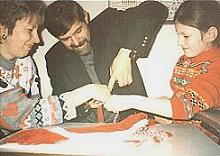

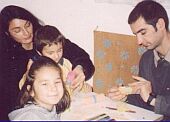
|
|
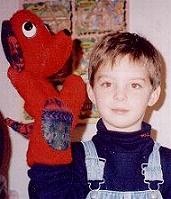 |
 ntegration into the normal class work: ntegration into the normal class work:
The work on
the project was an indispencible part of the school educational programme.
It was integrated permannently into the lesson units of most of the
different subjects, and became the basis of a special subject called
“Fairy Ethics” /twice a week/. |
|
 nhanced awareness of other
cultures: nhanced awareness of other
cultures:
The project gives an exquizite possibility for getting children
acquainted with the culture of different European people. /Every one of
the selected fairytales is a ground for learning more about the country
and people from which it originates.
The plots of the fairytales often
give information about customs and traditions of different countries and
people status/. With the help of fairytales the children get eagerly
engaged in looking for and finding out
Similarities and diversities
between European countries and people. / Way of life, architectural
monuments, traditional and historical fasion costumes,
etc./ |
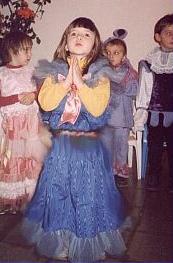 |
|
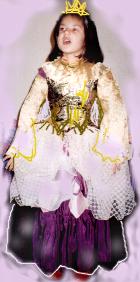 |
 kills
development kills
development
- Free outspoken communications, rich
vocabulary.
- Improved learning abilities, increased interest to the
learning process.
- A better comprehension and sound memorization in
all programme subjects.
- Improved level of language culture and
behavior.
- Use of fantasy and imagination.
- Logic and analytical
thinking.
-
Quick-wittedness.
- Artistizm.
- Complex handy skills.
- Improved
abilities for making decisions and drawing
conclusions. |
|
|
 full
collaboration between colleagues on a daily basis is essential for the
multysubject work on the project. full
collaboration between colleagues on a daily basis is essential for the
multysubject work on the project.
Each week special briefings took
place, for distributing the scheduled tasks, reporting the degree of tasks
fulfilment, successes or problems, and harmonizing the programme material
in the different subjects with the project
objectives.
|
|
|
|
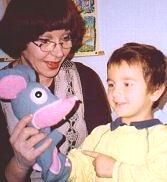
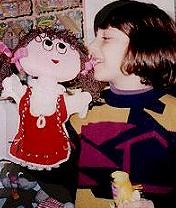
|
 evelopment
in teaching approach: evelopment
in teaching approach:
Purpouseful and systematic implication of
fairytales from different european countries in subject lessons for
Nursery and pre-school children./Age 3-7/
Thematic coordination and
matching of weekly lesson units in different subjects with pre-sellected
suitable fairytales.
Animation of lesson units teaching abstract
notions / ethics and mahematic/ with the help of characters,
attitudes, interactions and happenings taken from fairytales.
The
educational programme of our Kindergarten as a whole has been interrelated
to the project objectives. The project has an extremely broad and variable
subject basis. The enormous amount of different fairytales helps the
teachers engaged to find one or more story suitable for any
lesson. |
|
The  uropean
dimension is pursued in two main directions: uropean
dimension is pursued in two main directions:
Higher awareness of our
Bulgarian historic roots, cultural heritage, language riches and natural
beauties, which deserve love and respect for what they are, as an
indispensable part of the European home.
Developing self esteem and
the feeling of being affiliated to the European unity of people and
nations. Knowing about others and making ourselves known to them.
Respecting them and being respected the same way. Sharing the same human
values, and the same hopes for a better
future. |
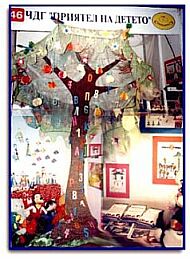 |
|

 eriodic
visits and collaboration of project coordinator Mrs. Tzvetana Platikanova,
colleagues and children engaged in the project in other schools and
Kindergartens,as : 31 School “Ivan Vazov”; Kindergarten “Prespa”; 38 School
“V.Aprilov”; School for socialy deprived children “Daskal Botyo”, Karlovo. And a
great number of schools patricipating in the Presentation of Private
schools in the National Palace of Culture.
eriodic
visits and collaboration of project coordinator Mrs. Tzvetana Platikanova,
colleagues and children engaged in the project in other schools and
Kindergartens,as : 31 School “Ivan Vazov”; Kindergarten “Prespa”; 38 School
“V.Aprilov”; School for socialy deprived children “Daskal Botyo”, Karlovo. And a
great number of schools patricipating in the Presentation of Private
schools in the National Palace of Culture.
These presentations got children
of other schools and institutions and colleagues /teachers and directors/
acquainted to the project objectives and activities.
The open lessons carried
out with other groups of children displayed the particularities in the project
related teaching methods.
 pen air
performances of fairytale dramatizations with the participation of children and
engaged in the project work proffessional actors.
pen air
performances of fairytale dramatizations with the participation of children and
engaged in the project work proffessional actors.
Distribution of a coloured
informative booklet /1000 issues/ presenting the Kindergarten and the two
Comenius projects it works on.
Multiple puppet and theatre shows in
different city halls, scuares, clubs, parks, etc…Periodic press-conferences,
introducing journalists and colleagues to the different stages of work on the
project.
 upils with
special needs:
upils with
special needs:
We have two
children with noticeable speech insufficiencies. In the process of work on the
project they gradually overcame their shyness and little by little started
expressing their thoughts and feelings more freely and fluently. By the end of
the first stage of the project, their pronunciation became more distinct, their
speech live and emotionally coloured, the vocabulary used – much
richer.
Along with the dissemination activities, our team meets and works
with different groups of children, many of whom are with different kinds of
special needs. In spite of all differences, the project activities have a
substantial impact for the better on children of all ages and educational
levels.
The school of our Greek partners works with physically and mentally
impaired children.Meeting them and working alongside with their teachers, we
felt ensured that their engagement in the project helped them to increase their
interest towards the learning process as a whole, bringing positive emotions and
desire for active perticipation in all project related
events.
 ND
PRODUCTS:
ND
PRODUCTS:
1.
EXHIBITIONS OF:
DRAWINGS,
ILLUSTRATIONS, PHOTOS, PUPPETS, MASKS, COSTUMES, ETC…/
2. PRINTED
MATERIAL: TRANSLATED STORIES, REPORTS AND REVIEWS .
3.
LIVE, AND RECORDED INTERVIEWS WITH PARTICIPANTS AND
SPECTATORS.
4.SOUND AND VIDEOTAPE RECORDINGS OF
PERFORMING ACTIVITIES.
5.
MONTHLY ON LINE MAGAZINE - TEXTS AND PICTURES FROM
DIFFERENT STAGES OF THE
PROJECT DURATION.
6.
FESTIVAL OF FAIRY TALES IN SOFIA, BULGARIA DURING THE FINAL
STAGE .

 he Project
objectives offer rich possibilities for a fruitful work with children on most of
the programme subjects. We find it necessary and very promising to continue the
in depth work, as well as the broader dissemination of the project ideas,
experience and achievements with the collaboration of new partners from
different European countries who are interested in our work so far. We already
have integrated three new schools from Scotland, Romania and Italy for the
following two years. We hope that our joint efforts and mutual support will
bring new quality to the teaching/learning process not only in our own schools,
but in many others all over Europe.
he Project
objectives offer rich possibilities for a fruitful work with children on most of
the programme subjects. We find it necessary and very promising to continue the
in depth work, as well as the broader dissemination of the project ideas,
experience and achievements with the collaboration of new partners from
different European countries who are interested in our work so far. We already
have integrated three new schools from Scotland, Romania and Italy for the
following two years. We hope that our joint efforts and mutual support will
bring new quality to the teaching/learning process not only in our own schools,
but in many others all over Europe.



 eriodic
visits and collaboration of project coordinator Mrs. Tzvetana Platikanova,
colleagues and children engaged in the project in other schools and
Kindergartens,as : 31 School “Ivan Vazov”; Kindergarten “Prespa”; 38 School
“V.Aprilov”; School for socialy deprived children “Daskal Botyo”, Karlovo. And a
great number of schools patricipating in the Presentation of Private
schools in the National Palace of Culture.
eriodic
visits and collaboration of project coordinator Mrs. Tzvetana Platikanova,
colleagues and children engaged in the project in other schools and
Kindergartens,as : 31 School “Ivan Vazov”; Kindergarten “Prespa”; 38 School
“V.Aprilov”; School for socialy deprived children “Daskal Botyo”, Karlovo. And a
great number of schools patricipating in the Presentation of Private
schools in the National Palace of Culture. pen air
performances of fairytale dramatizations with the participation of children and
engaged in the project work proffessional actors.
pen air
performances of fairytale dramatizations with the participation of children and
engaged in the project work proffessional actors.  upils with
special needs:
upils with
special needs: ND
PRODUCTS:
ND
PRODUCTS:  he Project
objectives offer rich possibilities for a fruitful work with children on most of
the programme subjects. We find it necessary and very promising to continue the
in depth work, as well as the broader dissemination of the project ideas,
experience and achievements with the collaboration of new partners from
different European countries who are interested in our work so far. We already
have integrated three new schools from Scotland, Romania and Italy for the
following two years. We hope that our joint efforts and mutual support will
bring new quality to the teaching/learning process not only in our own schools,
but in many others all over Europe.
he Project
objectives offer rich possibilities for a fruitful work with children on most of
the programme subjects. We find it necessary and very promising to continue the
in depth work, as well as the broader dissemination of the project ideas,
experience and achievements with the collaboration of new partners from
different European countries who are interested in our work so far. We already
have integrated three new schools from Scotland, Romania and Italy for the
following two years. We hope that our joint efforts and mutual support will
bring new quality to the teaching/learning process not only in our own schools,
but in many others all over Europe.